Concerns have been raised about possible water pollution with regard to Lynas' proposed plan to construct a permanent disposal facility (PDF) in Gebeng, Pahang.
The recently published environmental impact assessment (EIA) report highlighted several issues related to this matter.
The EIA report states that the PDF project would not pose a flood risk or lead to pollution of underground water and Sungai Baluk - the nearest river to the site - unless the worst-case scenario happens during the construction phase.
The report, published on Oct 12, states that the new PDF site is located in the Gebeng Industrial Estate, which is 30 metres from the Lynas Advanced Materials Plant (Lamp).
The proposed PDF site is located in the Sungai Baluk catchment area, which consists of two main rivers, Sungai Baluk and Sungai Tunggak. Both rivers flow into the South China Sea.
Although the new site is mainly surrounded by factories, there are five main settlement areas and nine educational institutions located within a 5km radius. Meanwhile, the Sungai Baluk catchment area has 12 settlement areas.
The settlement areas are mainly made up of villages.
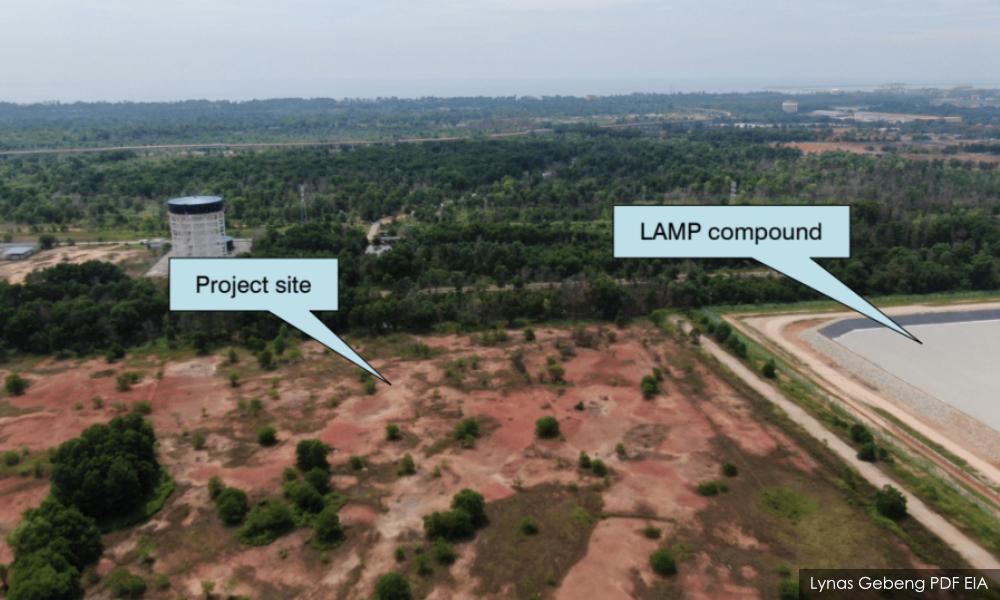
According to the report, the PDF is designed to permanently store radioactive water leach purification (WLP) residue produced by Lamp.
WLP residue consists of two unstable radioactive materials, namely thorium and uranium, as well as their progenies.
For instance, the activity concentration for U-238 and Th-232 in WLP residues are 0.3±0.4Bq/g and 4±7Bq/g respectively.
When they decay, they will form Ra-226 and Ra-228 respectively. The activity concentrations are 0.55±0.06 Bq/g and 6.5±1.0 Bq/g.
Operation, construction to run simultaneously
The EIA report states that the WLP residue is classified by the International Atomic Energy Agency (IAEA) as “very low-level waste” (VLLW), and therefore, does not require “a high level of containment and isolation and is suitable for disposal in landfill-type near surface repositories with limited regulatory control”.
The PDF project covers 25.25 hectares (62 acres). This includes four WLP storage cells that will take up 14.24 hectares (35.2 acres) or 56.76 percent of the project site.
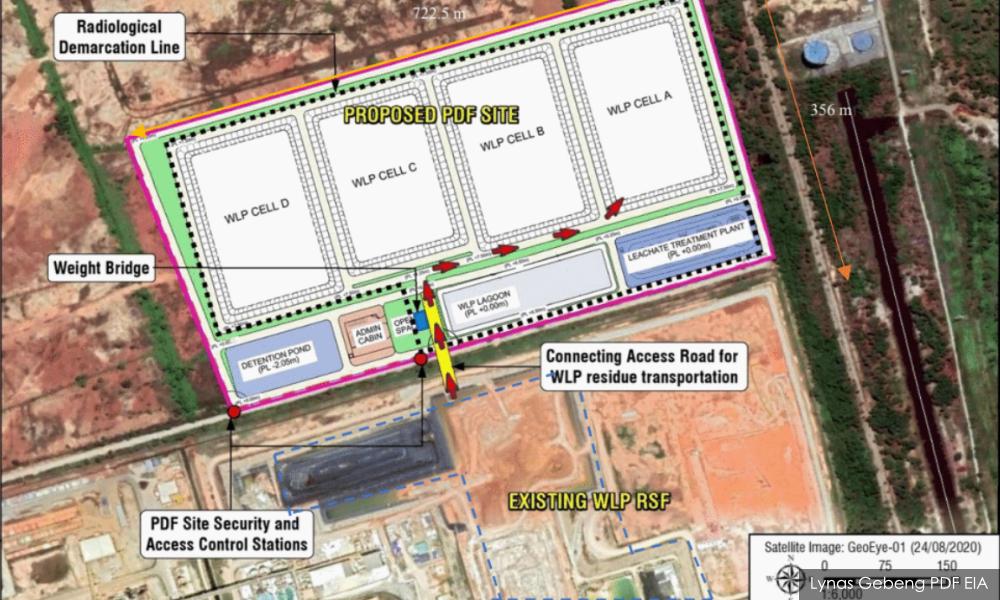
The project plan states that about 13 months after the project begins, the PDF would start operations once the effluent treatment plant (ETP) and the first PDF cell is built and ready to receive WLP residue.
WLP residue would begin to move from the residue storage facility (RSF) at Lamp to be emplaced in PDF storage cells.
At the same time, the construction for the remaining two storage cells would be carried out. In other words, construction and operation would run simultaneously.
When an emplacement activity in a PDF cell is completed, it would be capped. Emplacement would be carried out in the next PDF cell until all cells are capped.
The second PDF cell, or cell B, would be the last to store WLP residue. It would be utilised as an emergency containment pond (ECP).
Runoff during rainy days may pollute Sg Baluk
Other than the PDF cells, other facilities in the proposed site include a WLP lagoon, detention pond and an effluent treatment plant.
These facilities have a similar function as an emergency containment pond, which is to prevent surface runoff discharge into drainage or rivers that will directly lead to pollution.
The EIA report explained that there are two types of surface runoff: contaminated and uncontaminated. The former might come in contact with WLP residue while the latter does not.
These runoffs would form during rainy days or due to other factors.

The report anticipates that if there is a significant amount of rain, a surface runoff would be formed within the PDF cell and might infiltrate through the WLP residue before it is compacted or capped.
The contaminated runoffs might carry suspended WLP residue comprising radionuclides and heavy metals.
“Under normal rain events, the runoff will be contained in the WLP lagoon. However, should there be an extreme rain event... the lagoon may not be able to contain the runoff flow, leading to a flood of turbid runoffs containing WLP residue reaching Sungai Baluk,” the report states.
It also points out that although the high turbidites in the river are temporary, the deposits which contain heavy metals and radioactive particles might cause long-term impacts.
Set up ponds to store polluted runoff
Contaminated surface runoff would be stored in the WLP lagoon and discharged into the river after being treated in the ETP.
Uncontaminated runoff would flow through the detention pond before being discharged.
The temporary emergency containment pond or PDF cell B would help to prevent outflow from an uncapped PDF cell or WLP lagoon during an extraordinary rain event.
It is worth noting that during the final phase of the project, when WLP residue begins to be emplaced in PDF cell B, the cell would lose its role as an emergency containment pond and the outflow can only be directed to the WLP lagoon.
This window period is estimated to take 10 months.
The EIA report pointed out that the design of the PDF cells would help to reduce contact between the stormwater and WLP residue.
No longer a flood-prone area
As for concerns about flood risks, the report admits that the industrial area used to be a flood-prone area. But it declares that flood risks have no longer existed in the area for the past 10 years.
According to a flood coverage map drawn by the Department of Irrigation and Drainage (DID), the floods that occurred between 2000 and 2010 covered most areas of the Gebeng Industrial Estate, while the worst flood occurred in 2010, with the highest water level of 1.1m.
The EIA report explains that it was due to the area's low-lying topographical condition as well as a poor and unsystematic drainage system.
Nevertheless, the report claims that there was no flooding near or at the proposed site according to the flood map from 2010 to 2020.
This was due to an improved drainage system and the land being “raised and treated”.
The report also warns that improper design of stormwater systems could lead to polluted surface runoff discharging directly into the river.
Apart from this, an improper design of the detention pond or improper waste management might create flooding within the site.
Surface runoff that carries WLP residue could form accumulated sediments in the surrounding drainage and result in localised flooding.
PDF cells designed to prevent infiltration
Besides river pollution and flood risks, the EIA report addresses concerns of underground water pollution.
The report found that the proposed site to have a high body of underground water. There are 12 wells in the surrounding area, including those that were dug by villagers for watering crops during droughts.
In the EIA’s Terms of Reference (TOR) documents, the Water and Marine Division under the Department of Environment (DOE) states that the proposed site is a “high water table” area.
The department warned that if the regulatory measures are not implemented, river water, marine and underground water quality would be impacted.
But the report states that Lamp, which has been operating since 2012, and the RSF, have not caused any radioactive pollution so far.
The report adds that the design of the PDF is more secure and effective. Therefore, it concludes that WLP residue stored in the PDF is expected to cause less pollution.
The PDF is a “cell embankment” which would be constructed with reinforced outer and inner walls and the height of the cell embankment is proposed to be 7.5m.
The cell is to be constructed with steep slopes, which would help maximise its capacity while maintaining the total height as low as possible. The design will enable the PDF to withstand earthquakes.
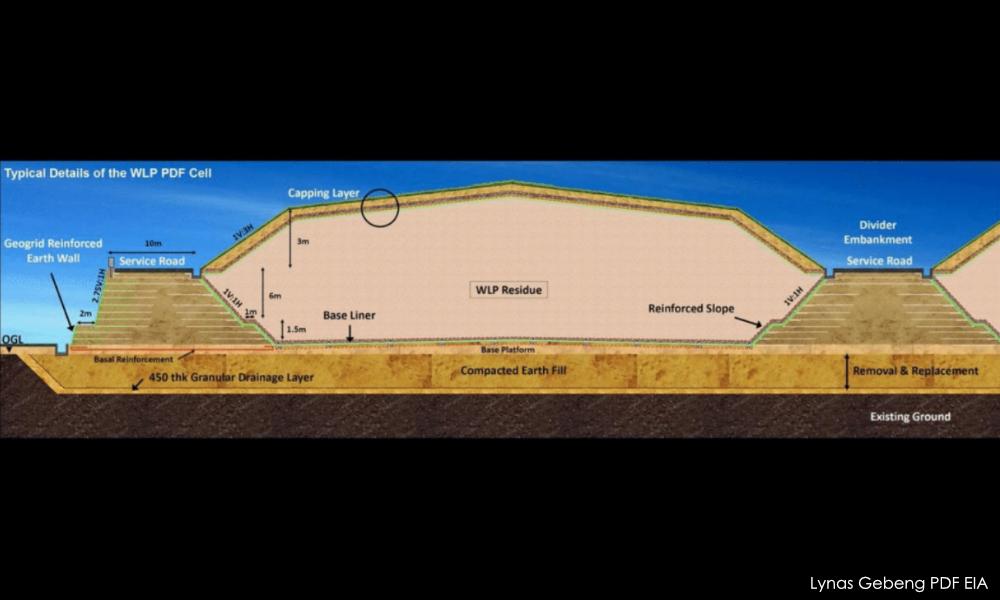
The PDF cell adopts a dual-liner cell base design concept, which uses HDPE membrane with Geosynthetic Clay Liner (GCL) to prevent and retard the contaminant from migrating to the biosphere.
The existing sand in the cell base platform level will be removed and filled with compacted cohesive soil.
“This will keep the height above groundwater level to the cell base by at least 1.5m to enhance the retardation of the pollutant from impacting the groundwater.
“The cell liner system... has a very low probability of breaching,” the report states.
Radioactive waste won't spread even if breach occurs
Based on groundwater flow modelling, the EIA report estimates the outcome when manganese or Ra-228 spills into underground water in “the worst-case scenario”, namely a breach of the cell liner system.
“There is no indication that the dissolved compounds will migrate beyond the boundary of the project site over a duration of 20 years.
“Vertical impact from the assumed release event is estimated to be contained within the compacted borrow soil barrier and the underlying native soil, up to the depth of approximately 6m below the ground,” it states.
The report also says that the monitoring term for the WLP PDF is 100 years, but it does not explain the reasons for building a groundwater flow model based on a 20-year scenario.
The report estimates the concentration of dissolved heavy metals or radionuclides to be far below the Contaminated Land Management and Control Guidelines (CLMCG) for tap water and the National Ground Water Quality Standard (NGWQS).
The EIA also report looks into concerns of underground water pollution during the construction stage. These include chemical material or fuel spillage and excessive pumping of underground water.
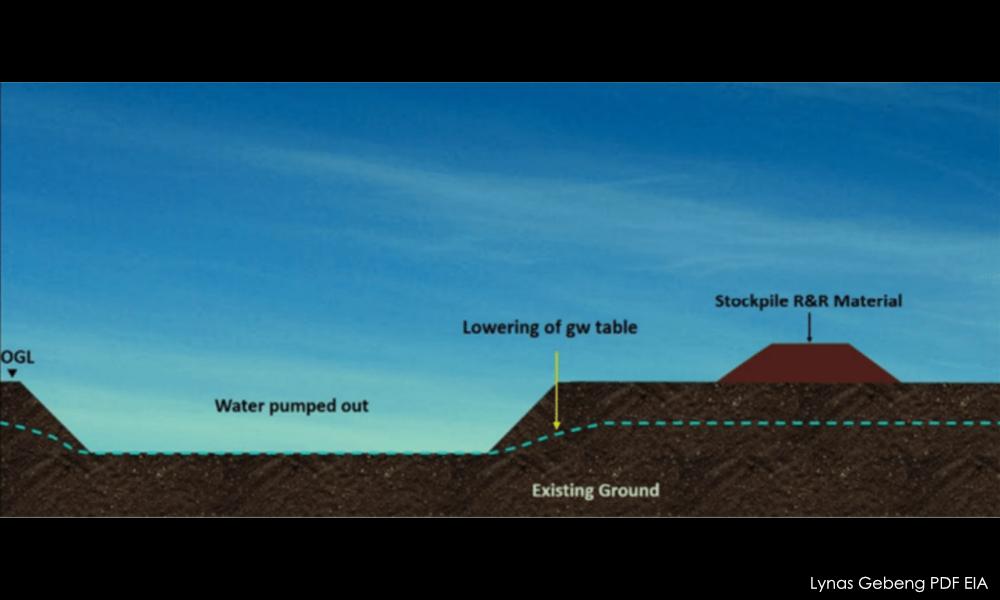
In order to prevent or mitigate the potential impacts of pollution, the main contractor Gading Senggara Sdn Bhd (GSSB) and other subcontractors have to implement the Environmental Management Plan (EMP).
This includes establishing an Environmental Monitoring Committee (EMC) to ensure all proposed “pollution prevention and mitigation measures” (P2M2) are implemented.
They also have to appoint an environmental officer to conduct inspection on environmental control measures; regularly reporting issues and corrective measures to the DOE.
If a major spill of hazardous material, chemical or oil occurs, an emergency response plan would be initiated and the affected area would be blocked with soil or other absorbents to prevent the liquid from entering drains or rivers.
Heavy metal pollution in Sungai Balok
Since the proposed Gebeng PDF site is located across the road from Lamp, the evaluation of the site's existing environment also offers a glimpse of the heavy metal pollution in the area.
The report points out that heavy metal concentration in the river near the Lamp site has exceeded the standard.
Through water quality sampling, the EIA team found that at Lamp’s effluent receiving drains, biochemical oxygen demand (BOD) and chemical oxygen demand (COD) were higher than other water samplings taken from Sungai Baluk.
When BOD and COD are higher, the biological pollution in the water is more severe.
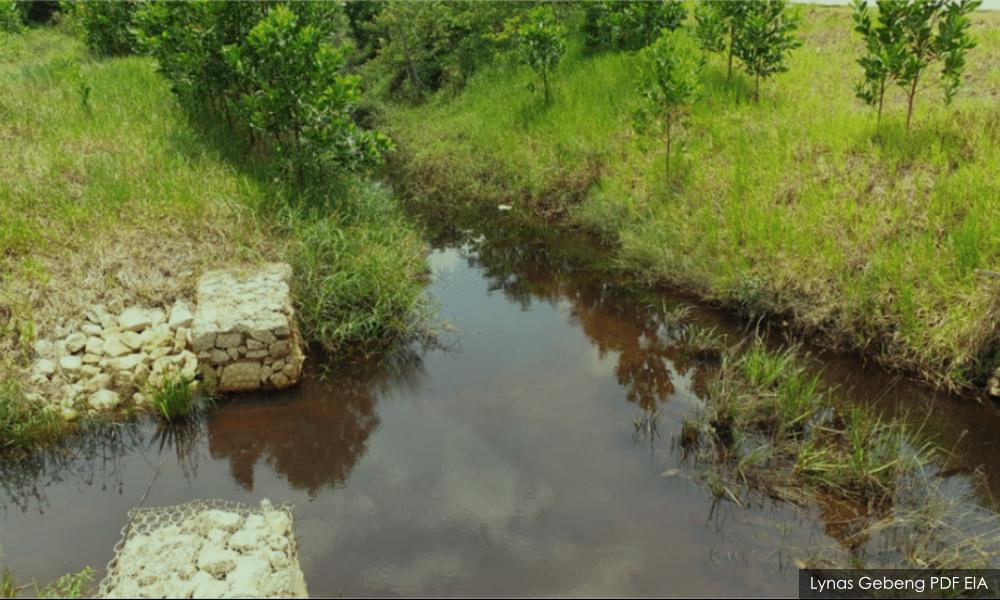
The concentration of aluminium and iron was also high, up to 4.6mg/L and 6.36mg/L respectively, exceeding Class V of the National Water Quality Standards (NWQS).
Class V refers to water that is not suitable for any purpose.
Lamp's discharge was also found to have led to a significant increase in conductivity of up to 16500μS/com, which is classified as Class V under NWQS. When the conductivity of water is higher, the water has more impurities in it.
Heavy metals due to 'geological reason'?
Through monitoring wells, the EIA team found that the groundwater of the proposed PDF site contained several types of heavy metals which exceeded parameters.
The concentration of aluminium, iron, manganese and arsenic in several wells exceeded the CLMCG tap water standards and NGWQS.
However, the report explains that it is attributable to the site’s original soil, which is peat soil and is “known to enhance the accumulation of heavy metals in groundwater”.
Therefore, the report concludes that the high concentration of heavy metals is due to “naturally occurring or geological in their original sources”.
Malaysiakini has reached out to GSSB and Lynas for their response.
Members of the public can view the EIA report until Nov 10. The deadline for feedback is Nov 25. - Mkini



No comments:
Post a Comment
Note: Only a member of this blog may post a comment.